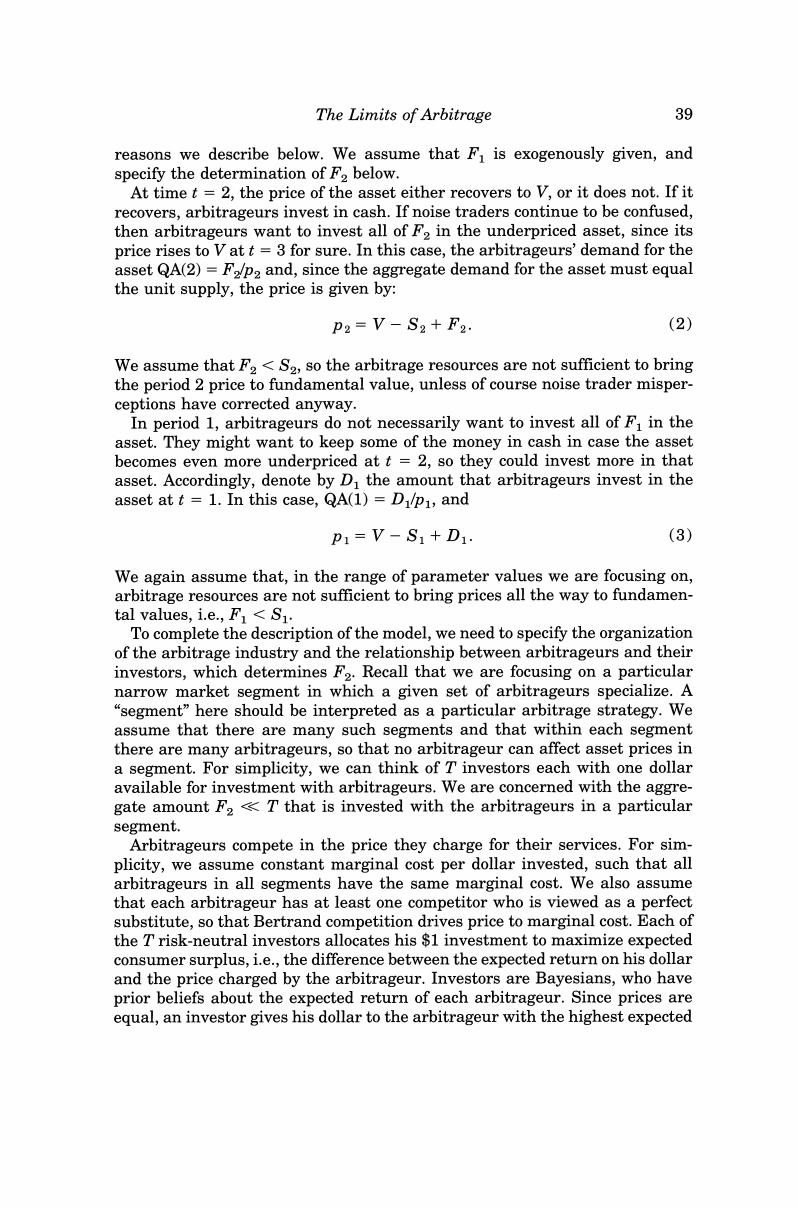正在加载图片...

The Limits of Arbitrage 39 reasons we describe below.We assume that F is exogenously given,and specify the determination of F2 below. At time t =2,the price of the asset either recovers to V,or it does not.If it recovers,arbitrageurs invest in cash.If noise traders continue to be confused, then arbitrageurs want to invest all of F2 in the underpriced asset,since its price rises to V at t=3 for sure.In this case,the arbitrageurs'demand for the asset QA(2)=F2/p2 and,since the aggregate demand for the asset must equal the unit supply,the price is given by: p2=V-S2+F2. (2) We assume that F2<S2,so the arbitrage resources are not sufficient to bring the period 2 price to fundamental value,unless of course noise trader misper- ceptions have corrected anyway. In period 1,arbitrageurs do not necessarily want to invest all of F in the asset.They might want to keep some of the money in cash in case the asset becomes even more underpriced at t =2,so they could invest more in that asset.Accordingly,denote by D the amount that arbitrageurs invest in the asset at t =1.In this case,QA(1)=D/p1,and p1=V-S1+D1. (3) We again assume that,in the range of parameter values we are focusing on, arbitrage resources are not sufficient to bring prices all the way to fundamen- tal values,i.e.,F<S. To complete the description of the model,we need to specify the organization of the arbitrage industry and the relationship between arbitrageurs and their investors,which determines F2.Recall that we are focusing on a particular narrow market segment in which a given set of arbitrageurs specialize.A "segment"here should be interpreted as a particular arbitrage strategy.We assume that there are many such segments and that within each segment there are many arbitrageurs,so that no arbitrageur can affect asset prices in a segment.For simplicity,we can think of T investors each with one dollar available for investment with arbitrageurs.We are concerned with the aggre- gate amount F2<T that is invested with the arbitrageurs in a particular segment. Arbitrageurs compete in the price they charge for their services.For sim- plicity,we assume constant marginal cost per dollar invested,such that all arbitrageurs in all segments have the same marginal cost.We also assume that each arbitrageur has at least one competitor who is viewed as a perfect substitute,so that Bertrand competition drives price to marginal cost.Each of the T risk-neutral investors allocates his $1 investment to maximize expected consumer surplus,i.e.,the difference between the expected return on his dollar and the price charged by the arbitrageur.Investors are Bayesians,who have prior beliefs about the expected return of each arbitrageur.Since prices are equal,an investor gives his dollar to the arbitrageur with the highest expected